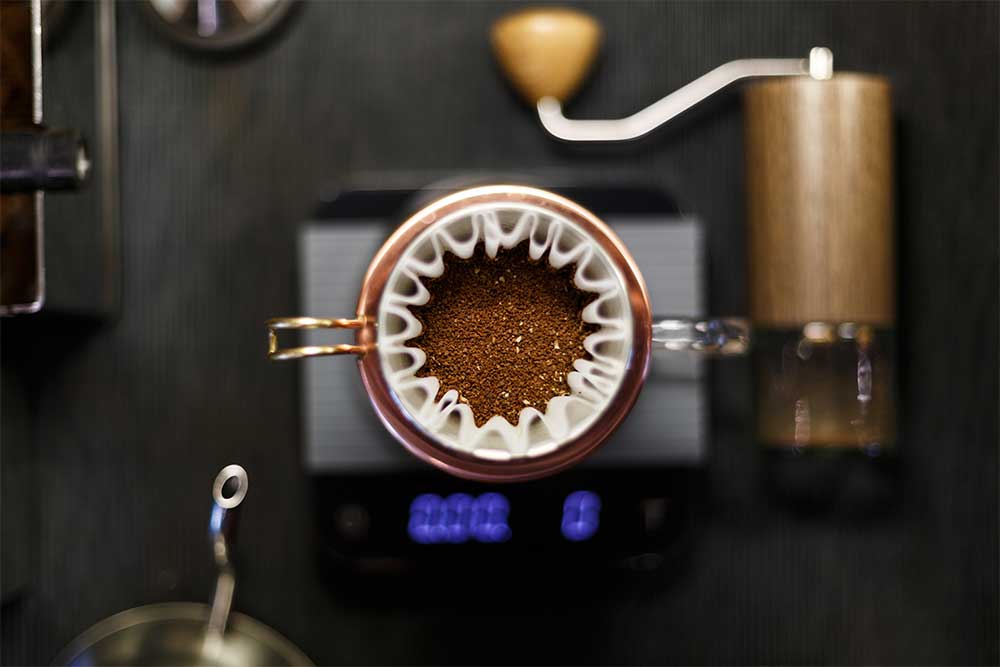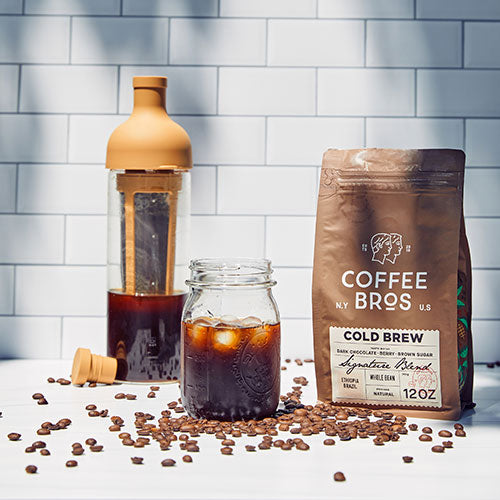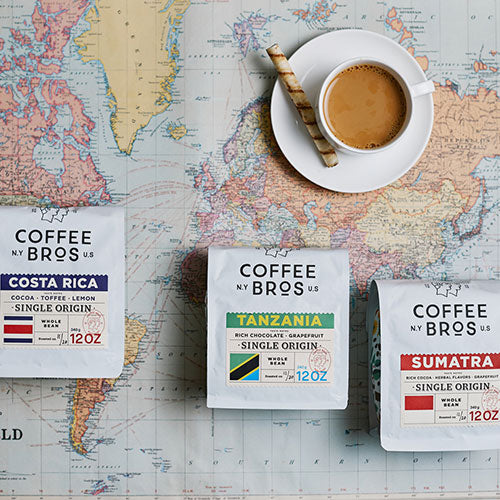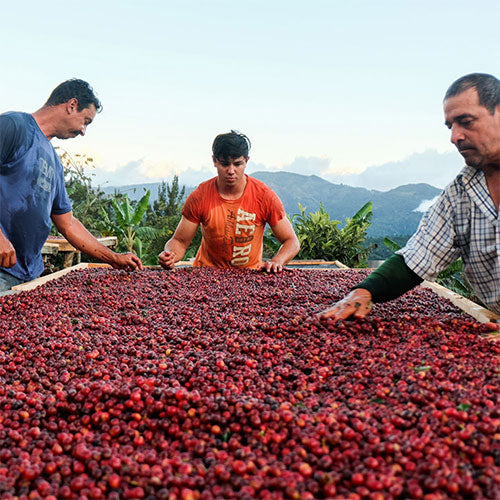How To Make The Perfect Pour Over
Introduction
Our ultimate pour-over brewing guide was developed to provide a comprehensive summary of all things related to pour-over coffee. Whether you are new to brewing coffee at home or are already an experienced brewer looking to learn some advanced techniques, this guide is the perfect resource for you.
We cover a wide range of topics, including the advantages of using a pour-over device compared to a drip machine, the essential equipment you need to get started with pour-over brewing, and recommended brewing temperatures, techniques, and recipes to ensure you achieve the perfect cup of coffee every time.
So sit back, prepare yourself a delicious cup of coffee, and enjoy our Perfect Pour-Over Guide, the ultimate resource for brewing exceptional coffee.
The Perfect Pour Over: Table of Contents
- What is a Pour Over Coffee
-
What is the benefit of making a Pour Over Coffee
- Time
- Temperature
- Flow Rate
-
What equipment do you need for a Pour Over
- Grinder
- Brewing device/Filters
- Kettle
- Scale
- What brew ratios should you use for a Pour Over
- What is the optimal brewing temperature for Pour Over coffees
-
What recipe and technique should you use for a Pour Over
- Scott Rao pour over recipe
- Lance Hendrick pour over recipe
- James Hoffman pour over recipe
- What is the best coffee for a Pour Over
What is a Pour Over Coffee
Pour-over coffee is a brewing method that involves manually pouring hot water over coarsely ground coffee beans, which are placed in a paper filter inside a brewing device like Hario’s V60. This allows the coffee to drip directly into a mug or server. What sets pour-over coffee apart from other brewing methods is the control it provides over the factors that affect the taste of the final product, such as the brew length (bloom and flow rate), temperature, and recipe/technique. In contrast, when using a drip machine, many of these factors are outside of your control.
Although pour-over brewing is more hands-on and time-consuming than other methods, it can result in some of the most delicious cups of coffee you've ever had if executed properly.
What is the benefit of brewing with a Pour Over
Summary
The benefit of brewing a pour-over coffee is the direct influence you as the barista have on brew length (time), temperature, and recipe. Many of these inputs can't be influenced with automatic machines which can drastically reduce the quality of your brew.
Every coffee is unique, from the roast type (light, medium, dark), the varietal (Gesha, SL-28, Pink Bourbon), and the processing method (washed, natural, honey). All these factors drastically influence how coffee should be brewed and catering your inputs (time, temperature, and recipe) to the coffee type will give the exceptional results you are looking for. Furthermore, you as the consumer of the beverage may want the final brew to taste a certain way, maybe you like your coffee stronger, or want a coffee with high clarity and a low coffee-to-water ratio, all these options you have the influence over when brewing with a pour-over.
Let’s break down why time, temperature, and recipe/technique have a big impact on your final beverage and how you can influence these with pour over brewing.
Time
The time corresponds to the time it takes to reach your recipe’s end weight. If your goal is to complete your brew within 3 minutes, you would alter your grind size, pour rate and frequency, and length of bloom to help you hit that target.
Let’s look at how each factor within time can influence your total brew length. There are only a few of these that an automatic machine can influence but not all.
Grind Size: The grind size matters across all brewing methods and will impact your coffee’s total brewing time. Finer ground coffee will brew much slower than one that is ground coarser. Your grind size will correlate to how fast the water flows through the bed of coffee grinds and directly influence your extraction.
Coffee that is ground too fine may extend your brew beyond your intended brew time and create a drink that is over-extracted. The opposite would happen if you ground too coarse leaving you with a thin, under-extracted, and sometimes sour brew.
We often shoot for a medium coarse ground coffee when brewing for pour-over, but slight adjustments may be needed to hit your target time.
Bloom: The blooming process in coffee is the release of carbon dioxide gas that occurs when water is poured over freshly roasted coffee grounds. To let the coffee bloom, simply pour a small amount of water over the grounds and wait for 30 to 40 seconds for the gas to escape.
The “blooming” process is an extremely important part to pour over brewing and many recipes call for a bloom to last from 30 seconds up to 2 minutes. Altering this time can rarely be done on automatic machines but will have a drastic impact on the final beverage taste.
Pouring frequency and method: The way you pour your water into the brewing vessel makes a big difference.
There are several ways of approaching this and our recipes will detail this more below. You can simply do one long slow pour or in a planned frequency (pouring “x” grams every 15 – 30 seconds).
We suggest pouring water into your brewer once the water is roughly 1cm above the coffee grounds. Doing this will keep an even and consistent flow, and you repeat this process until you reach your final brewing weight.
Temperature
Temperature is sometimes the Cinderella of brewing parameters and is often tossed aside as unimportant.
Like all other inputs when brewing coffee, the temperature can also have a massive impact on your brew quality. Using the wrong temperature can cause extremely acidic and sour tasting cups of coffee or the opposite toward extremely bitter and harsh.
Regular coffee machines can rarely brew beyond 200 degrees Fahrenheit which may be ideal for very dark roasts (which do better at brewing at lower temperatures) but does a disservice to those wanting to get the most out of lighter roasts. There are some machines that don’t allow you to adjust the temperature at all which will result in an inconsistent and lackluster cup of coffee each time you brew.
If you own a regular drip coffee machine, it may be best to avoid lighter roasts as they do the best brewing almost right off boil which automatic machines cannot replicate. The control of temperature and the ability to brew at any temperature you deem appropriate for that coffee is what makes the pour-over a superior brewing method to any drip machine you can buy.
Recipe and Technique
We will touch more on pour-over recipes later in this post, but the point here is to highlight the control one has when brewing a pour-over in comparison to a regular drip machine.
The Specialty Coffee Association recommends a 1:18 coffee-to-water ratio as their Golden Cup Standard for many brewing methods like pour-over, French Press, Chemex, and drip machine. The brew ratio is one part of your total recipe for pour-overs as other factors such as pouring technique (flow, height) and frequency play a role in the outcome of your brew.
Different recipes may call for pouring water from your kettle at a certain height to create “agitation” within the coffee bed. While others may suggest pouring water onto the grounds every 15 seconds until you reach your end recipe. You may also hear the term “spin the slurry” which ultimately is another form of agitation to the coffee grounds which can help with overall flow and extraction.
Pour-over recipes can be somewhat complex but ultimately are a simple brewing technique once you understand the influence of time, temperature, flow rate, and technique on the brew.
What equipment do you need for a Pour Over
Our Suggested Equipment
- Grinder: A quality conical or flat burr grinder (or start with pre-ground coffee to get the hang of pour over brewing)
- Brewing Device: Hario V60
- Kettle: Fellow Stagg Gooseneck Kettle
- Scale: Any scale that can read grams and ounces
Brewing a pour-over at home can be as cheap as $75.00 to get started (this excludes a grinder) or as expensive as $475.00 (includes a high-quality grinder and electric kettle with temperature readings).
Even if you opt for the lower end of the scale to get started where you buy pre-ground coffee (not ideal you can read why here), a Hario V60, and a pour-over gooseneck kettle you can be all in for less than $75.00. Even with this rookie starter pack, you will get more exceptional cups of coffee than when relying on an automatic drip machine.
Below, we’ll break down all the equipment needed to brew the perfect pour-over coffee from entry-level pieces of equipment to those looking for café and barista quality pieces.
Grinder vs. Pre-ground Coffee
To begin with, you will need to either buy pre-ground coffee or have access to a grinder. Our article explains the benefits of grinding your own coffee and why using whole beans is superior to pre-ground coffee. After reading the article, you will understand why investing in a good grinder is worthwhile.
If you're new to the world of coffee, a reliable conical burr grinder such as the Baratza Encore, which costs less than $170.00, would be a good starting point. This is the same grinder that many coffee professionals began with before upgrading to more advanced grinders with better burr sets for more consistent grinds.
The question of when to invest in a grinder ultimately comes down to your personal choice. However, we strongly recommend doing so as we believe it is a crucial step in achieving consistently exceptional coffee.
Brewing Device
When it comes to pour-over coffee, there are various equipment options available, each with its unique features and following. However, in terms of quality and price, the Hario V60 is unbeatable. Here are your options for pour-over coffee brewers:
Classic pour-over options:
New and lesser-known options:
The differences between these brewers are based on several factors, such as:
-
Material: The material of the brewer affects temperature stability during the brewing process, and this can impact overall extraction. The options above include metal, ceramic, and plastic brewers.
- Suprisingly, plastics are excellent insulators, meaning they can efficiently trap heat — a quality that can be an advantage in something like a coffee brewer. -Source: news.mit.edu
-
Flow rate: The design of the pour-over brewer, whether flatbed or cone-shaped, impacts water flow through the coffee and filter and into your mug or server. The shape differences affect coffee-to-water contact, which ultimately impacts flavor quality. Each brewer type requires slightly different grind settings to maximize device performance.
-
Filter type: Filter types vary based on brewer selection. Flatbed brewer filters have a flat bottom, while cone-shaped filters are, as the name suggests, cone-shaped. Choosing the correct filter is crucial, as the wet filter must make perfect contact with the brewer to ensure a consistent shape that impacts flow and extraction. Manufacturers offer filters with different thicknesses to further affect flow rate, which is useful when brewing different roast types (light, medium, or dark).
Kettle
Precision is key when it comes to pour-over brewing so your standard widemouthed kettle will not work for this brewing application.
The recommended kettle for pour-over brewing is the gooseneck kettle which helps with precision pouring and consistent flow rates. It is much easier to control where your water is going and how fast it is flowing with a gooseneck kettle versus the alternative widemouthed version. As we noted earlier in the article, timing is one of the three key factors for the perfect brew and a gooseneck kettle will keep your timing under your control.
You do not need to go fancy here but there are options for electric gooseneck kettles upward of $150.00. The perk of an electric kettle is how quickly it heats up as well as its ability to hold any temperature you set. If you want to nail your temperature exactly each time, an electric kettle like the Fellow Stagg is ideal. Otherwise, you can find rather cheap gooseneck kettles with built-in thermometers on Amazon for under $30.00.
Scale
To follow a recipe precisely, you will require a scale that can report measurements in grams, ounces, and preferably time as well. This is an area where you can save money and need not splurge on the purchase. You can purchase a scale with the essentials for under $30.00 or go for a high-end one with built-in brew guides.
Hopefully, this section helps you decide which direction to take when it comes to pour-over brewing. As with any hobby or passion, it is best to start slowly and affordably to get a feel for things, determine your preferences, and then invest in the equipment you believe is necessary.
What brew ratios should you use for a Pour Over
What are coffee brewing ratios:
Coffee brewing ratios are the number of coffee grounds in grams to water in grams used as a starting point across all coffee brewing methods.
The Specialty Coffee Association recommends a 1:17 - 1:18 coffee-to-water ratio as their Golden Cup Standard for many brewing methods like pour-over, French Press, Chemex, and Autodrip.
A 1:18 ratio means that for every 1 gram of coffee grounds used, you would brew using 18 grams of water.
Golden Cup Standard:
The Golden Cup Standard is an excellent baseline for any brewing method, including pour-overs. The standard recommends a coffee-to-water ratio of 1:17 to 1:18, meaning you would use 17 grams of water for every 1 gram of coffee grounds.
Some may find this ratio to be a bit weak, resulting in a slightly watery cup of coffee. The Golden Cup Standard is particularly well-suited to those seeking clarity in their coffee, light roast enthusiasts, or those who prefer single-origin coffee.
Starting with the Golden Cup Standard is an excellent idea, even though it is a bit mild. You can then gradually increase the coffee-to-water ratio to achieve a stronger brew.
Our Recommendation for Brew Ratios:
We suggest three different coffee-to-water ratios for pour-over brewing, depending on whether you prefer a mild, average, or robust cup of coffee.
Mild (high clarity): 1:17 or the SCA Golden Cup standard
Average: 1:16
Robust (high body): 1:13
You can use these ratios as a starting point and then adjust the ratio up or down to achieve the desired level of clarity or body. Our coffee calculator provides exact measurements, and please note that all ratios are based on 1 gram of coffee to "x" grams of water.
Ideal brewing temperature for Pour Over coffee
The recommended temperature range for brewing hot coffee, regardless of the method, is between 197-205 degrees Fahrenheit. Using a kettle with a thermometer is the best way to achieve this temperature range, but alternatively, you can boil water and let it sit for 30 seconds to 1 minute to cool to the optimal temperature.
The temperature of the water used for brewing can greatly affect the taste of the coffee. If the water is too hot, it can result in a bitter or burnt taste, while water that is too cool can result in a flat and weak cup of coffee.
Ideal brewing temperature for light-roasted coffee:
The ideal brewing temperature for Light Roast Coffee is right off boil or between 203 – 212 degrees Fahrenheit. The higher temperatures help prevent sourness, and high acidity is lighter roasted coffees.
Ideal brewing temperature for medium-roasted coffee:
The ideal brewing temperature for Medium Roast Coffee is about 30 seconds off boil or between 194 - 203 degrees Fahrenheit. The moderate brewing temperature helps keep the medium-roasted coffee balanced and rich.
Ideal brewing temperature for dark-roasted coffee:
The ideal brewing temperature for Dark Roast Coffee is about 1 minute off boil or between 185 – 195 degrees Fahrenheit. The lower temperature helps to rid bitterness and highlight the sweetness in the dark roasted coffee.
Pour Over recipes and technique
We've curated three pour-over recipes for you to try, each designed to work well with different levels of coffee roast types. Use the suggested water temperatures above for each roast type, so all you have to do is follow the recipe and adjust the coffee-to-water ratio based on your personal preferences.
What's great about these recipes is that they're simple and easy to follow, making it easy to replicate them. And once you've given them a try, feel free to experiment and adjust the recipe to create your own perfect pour-over. With these recipes as a starting point, you'll be well on your way to making delicious pour-over coffee at home.
Scott Rao Pour Over Recipe:
- Grind size: Medium coarse
- Brew Ratio: 1:16.36
- Water temperature: 85 - 100 degrees Celsius (revisit the above section on brew temperatures)
- Bloom size: 3x the weight of your coffee with water.
- Bloom length: 45 seconds
- Remaining pour: After the bloom is complete, pour the remaining water in one long pour keeping a consistent height of your kettle at all times. Give your coffee bed a stir or spin at around 1:45 seconds to help with the flow.
Lance Hendrick Pour Over Recipe:
- Grind size: Medium coarse
- Brew Ratio: 1:14 (darker roasts) - 1:17 (lighter roasts)
- Water temperature: 85 - 100 degrees Celsius (revisit the above section on brew temperatures)
- Bloom size: 3x the weight of your coffee with water. If you are using 20 grams of coffee, use 60 grams of water for your bloom.
- Bloom length: 1 – 2 minutes – user bloom time closer to 2 minutes if the coffee is fresh off roast.
- Remaining pour: After the bloom is complete, pour the remaining water at 6-8 grams a second until you hit the final weight. If the coffee is draining too slowly, it is okay to swirl the bed of coffee to help improve the flow rate.
James Hoffman V60 Recipe:
- Grind size: Medium-fine
- Brew Ratio: 1:16.67 (this recipe calls for 15 grams of coffee meaning 250 grams of water
- Water temperature: 85 - 100 degrees Celsius (revisit the above section on brew temperatures)
- Bloom size: 3.3x the weight of your coffee. For this recipe it would call for 50 grams of water for your bloom.
- Bloom length: 45 seconds
- Remaining pour: After the bloom is complete, pour 50 grams of water every 20 seconds until you reach your final weight.
- Total time: 3:00 minutes
What is the best coffee for a Pour Over
Pour-over brewing is a manual method that offers unparalleled flexibility and control over the brewing process, making it the ideal choice for any type of coffee. With a few simple adjustments to your temperature and brew ratio, you can create delicious cups of coffee with light or dark roasts. Unlike automatic drip machines, pour-overs allow you to customize the brewing experience by adjusting the temperature, bloom time, pouring technique, and flow rate. This versatility means that you can create the perfect cup of coffee to suit your taste preferences.
While pour-overs can be used for any type of coffee, they are particularly well-suited for high-quality, well-roasted and sourced coffees such as single-origin or award-winning coffees like those from the Cup of Excellence. Using an automatic drip machine with a premium coffee would be a missed opportunity to fully appreciate its unique flavor profile. Therefore, pour-over brewing is a method reserved for those who want to savor and enjoy the finer aspects of specialty coffee.




